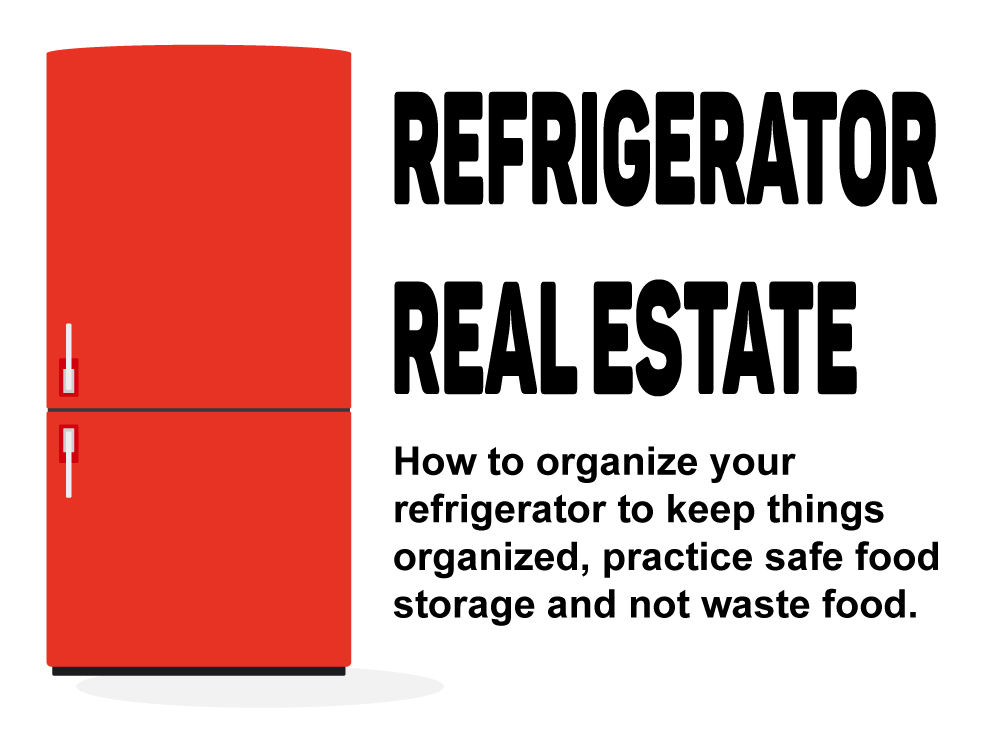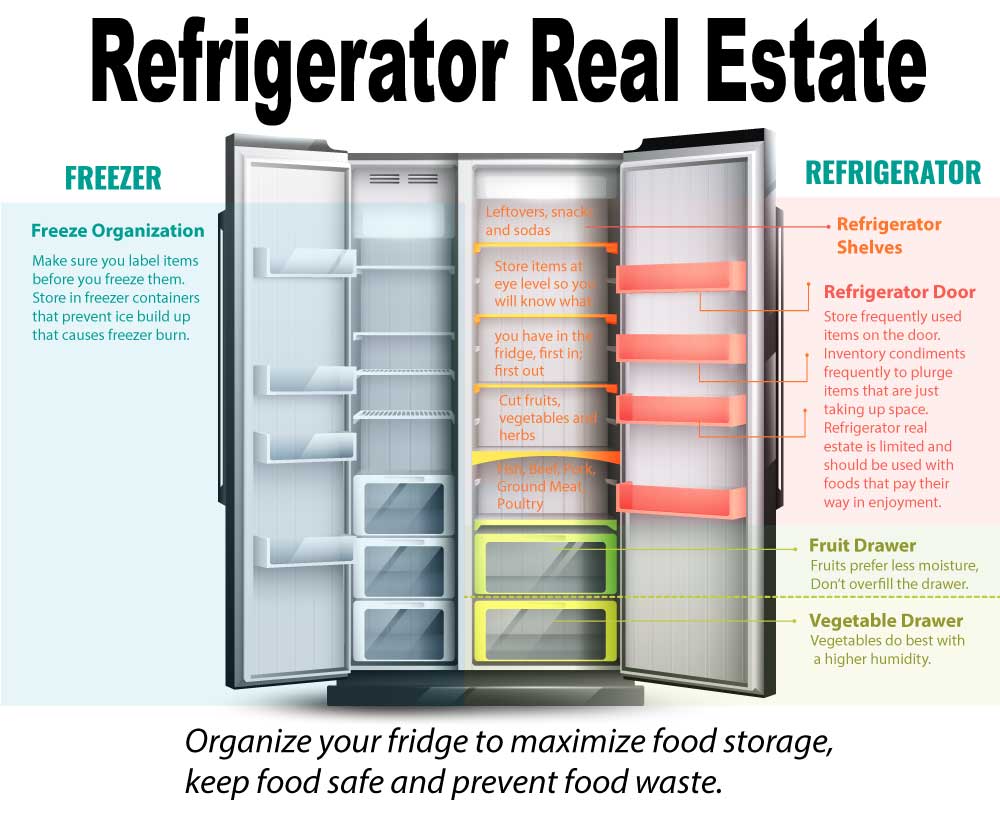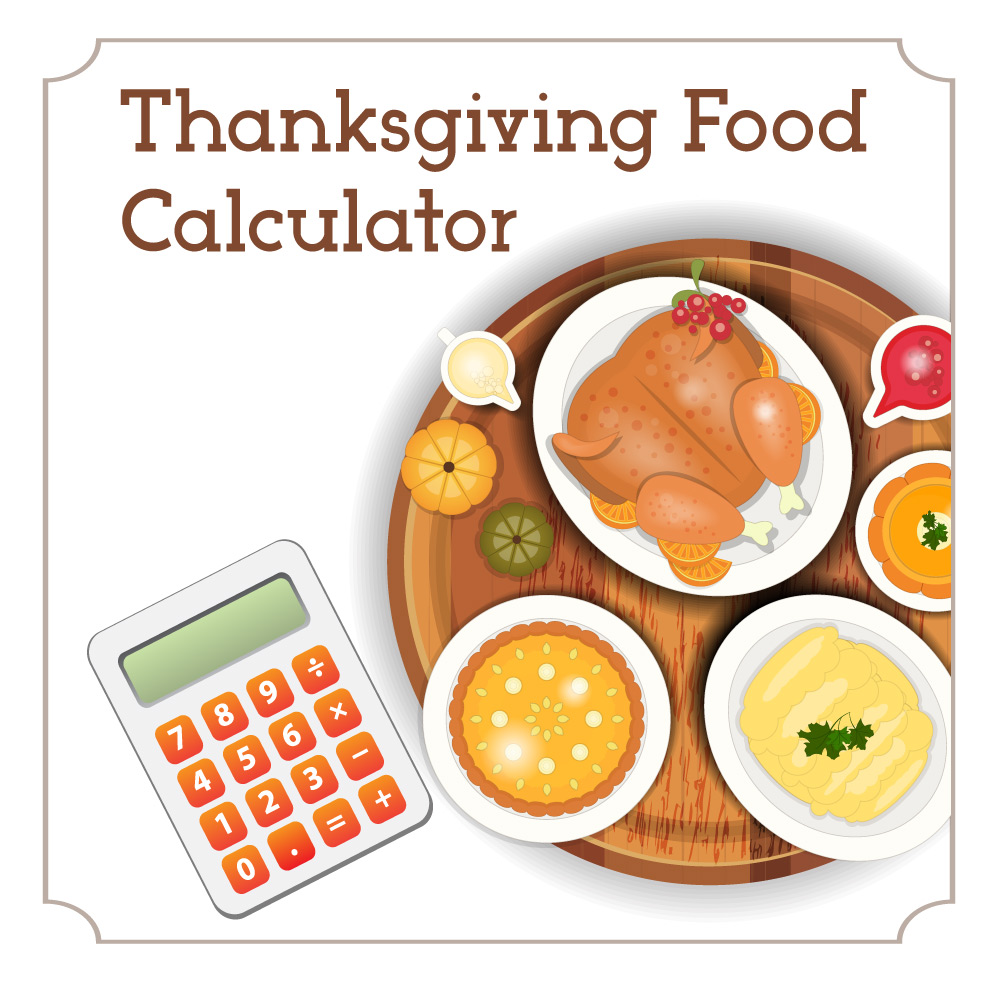
The space in your refrigerator is defined and limited so plan out your refrigerator real estate to keep things organized, practice safe food storage and not waste food. By zeroing in on what should be stored where you can save money, time, and food.
Think about how often you open your fridge and what you take out when you open the refrigerator. Store frequently accessed items where they are easily accessible in order to reduce the time the door is open.
Refrigerator Zones
Break down your refrigerator into zones. Each zone has its own cooling and humidity environment.
Refrigerator Door Space
Every time your refrigerator door gets open and closed, it lets the cold air out and exposes whatever is stored on the shelves and in the compartments to the room temperature air in your living space. This change in temperature means the stuff stored on the door should be what you either access the very most of what is least bothered by the change in temperature. You have little control over how the refrigerator door shelves are set up, you can store the most temperature stable foods there.
Most refrigerators have built-in shelves on the door for milk and juice, since those items are accessed every day. Likewise, your refrigerator door will likely have a covered compartment for things like butter and possibly eggs. Shelves are the perfect place to store your all condiments and any oils that you keep refrigerated.
Refrigerator Drawers
Most refrigerators have a couple of crisper bins near the bottom of the fridge. These are custom-made to store produce. You may be able to adjust the humidity in the bins by opening or closing the moisture vent. Just remember that vegetables require a more humid environment than fruit does.
By organizing your vegetables in the drawers with the firmer veggies (like carrots, celery, cabbage, and broccoli) stored in bags at the bottom and lighter weight veggies (like zucchini, green onion, and radishes) in the middle. Store leafy greens in bags on top. Go through your produce every couple of days as you prepare a meal to ensure you use the vegetables while still in their prime.
Whole fruits should be stored (not in plastic bags) in a separate drawer with the moisture control open. Apples, citrus fruits, pears, ripe avocados, (see this post for how to choose avocados, ) peaches, etc. Keep most fruits on a counter until ripe and then move them to the refrigerator to hold at peak flavor for up to 5 days. Grapes should be stored in the perforated bags they are sold in. Berries should also be stored in the plastic containers on top of the fruit in the fruit drawer.
Refrigerator Shelves
These spaces are the prime place for refrigerator real estate! Remember that heat rises so the higher shelves are naturally less cool than the lower shelves. Any leftovers, snacks, etc should occupy a place of honor on the top shelf of the refrigerator. Soda and flavored water also should be stored here. You can purchase trays for the group and organize cans to maximize the space. An investment in food storage containers that are modular and can stack will pay for themselves in preventing food loss and smart using the space effectively.
When storing food, try to group like things together and keep things from getting buried in the back recesses. Out of sight equals out of mind and that equals wasted food!
Once avocados and melons have been cut in half, store them tightly covered on the upper shelves of your refrigerator. Fresh herbs should be gently washed as soon as they get home from the store. Remove the wire wrapper that holds the herbs together before rinsing and shake the excess water from the herb bundle. Gently roll the herbs in a paper towel and loosely store in a plastic bag. Or store herbs in a container with an inch of water. Place the stems in the water and loosely tent with a plastic bag.
Lower shelves get progressively cooler and are where you should store food items that go bad quickly. If you have a drawer dedicated to cheese and processed meat. Organize them with meats in one side and hard or semi-soft cheeses together. Stored properly foodstuff placed in the cheese drawer will keep for several weeks.

Food Safety for Refrigerator Real Estate
Since the crisper bins and cheese drawers are closed compartments, just make sure the foods stored inside are properly wrapped and used or avoid food waste. A clean fridge is important to keep everything fresh. Schedule frequent cleaning of the shelves and drawers to get rid of any spills and odors. This will also help you remember what you have in your refrigerator.
Organizing the shelves with an eye to food safety. Prepared foods and leftovers belong on the top shelf. Cut fruits and vegetables go below. The next shelf is where fish should be placed, Then beef and pork, ground meats should be stored next and that leaves poultry to be stored under that. This order prevents any cross-contamination. I like to store meats in shallow plastic containers that can control any leaks from drippy bags. It is easier to quickly rinse out a plastic bin that has a few drips and returns it to the fridge. An added bonus is that the bins organize your refrigerator shelves and group like meats together.
Tips to Maximize Refrigerator Storage
- Store frequently used items on the door of the refrigerator to minimize the time the fridge is open.
- Go through your condiments often since there is limited space available in your refrigerator. If you don’t like a dressing or sauce, don’t hang onto a half-open jar.
- Store leftovers at eye level so you will eat them.
- When you buy foodstuffs, remember the rule first in, first out. This means use the older food first.
- Schedule regular cleaning of the inside and outside of your refrigerator to keep odors at bay.




Leave a Reply